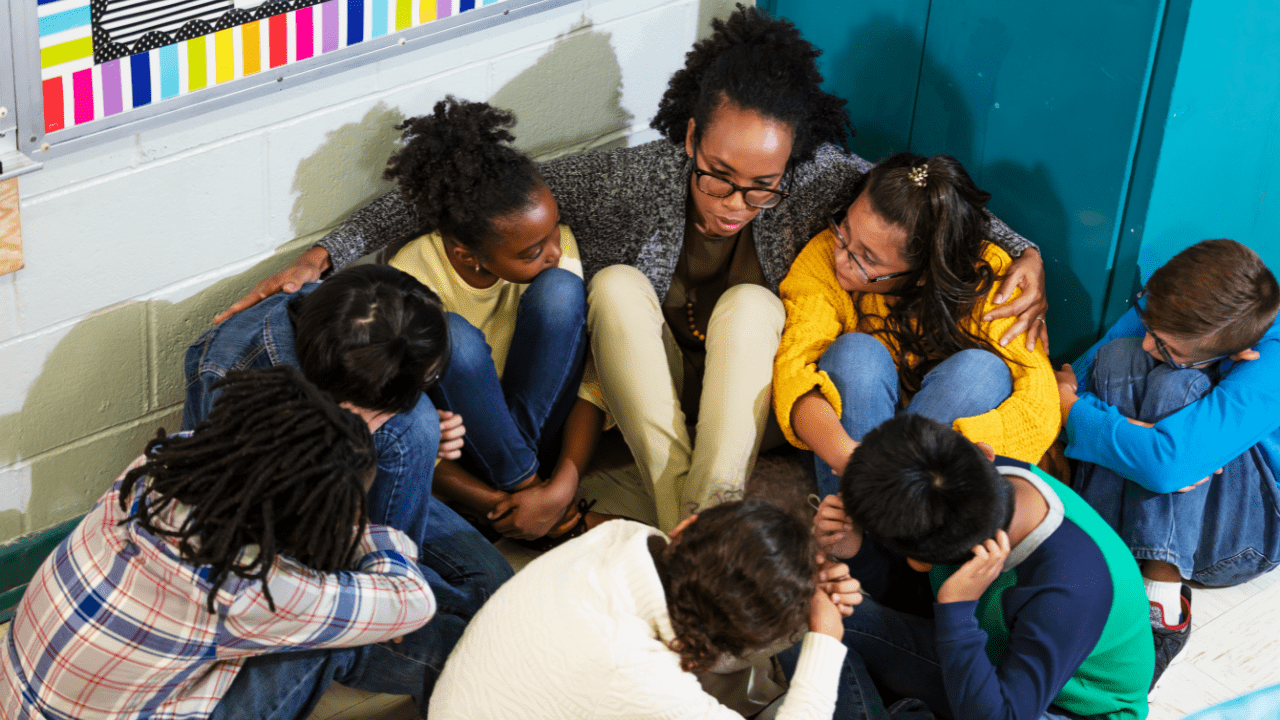
No one ever wants to find themselves in an active shooter situation. But if you are, it’s important to know how to respond. Today’s guest is Katherine Schweit. Katherine is an attorney, consultant, and retired FBI special agent who created and led the FBI’s Active Shooter Program after the horrible tragedy at Sandy Hook Elementary School. She joined a White House team working on violence prevention matters, led by then Vice President Biden. She is the author of Stop the Killing: How to End the Mass Shooting Crisis, How to Talk About Guns With Anybody, and the FBI’s research on mass shootings, a study of 160 active shooter incidents in the United States between 2000 and 2013. She was part of the crisis team responding to shooting incidents including at the Holocaust Memorial Museum, the Pentagon, and the Navy Yard in Washington, DC.
“In 2020, the CDC determined that gun deaths in youth 19 and younger exceeded the deaths by traffic accidents in the same age group.” - Katherine Schweit Share on XShow Notes:
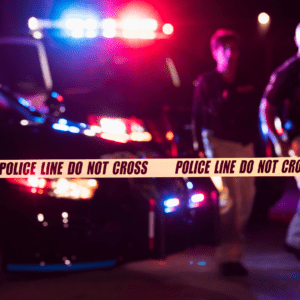
- [1:14] – Katherine shares her background, her experience in the FBI, and her work in the Active Shooter Program.
- [3:05] – In her work, she spent time with parents and families of those killed in mass shootings.
- [4:23] – What constitutes a mass shooting or an active shooter situation? There is no real definition.
- [6:10] – Most mass killings are domestic, particularly murder/suicides, but those will not show in data. Katherine explains what the FBI looks at.
- [8:44] – Journalists and media impact what stories are news-worthy.
- [10:21] – Katherine released her book How to Talk About Guns With Anyone to keep the conversation going.
- [13:19] – In 2020, the CDC determined that gun deaths in youth 19 and younger exceeded the deaths by traffic accidents in the same age group.
- [15:56] – Safety isn’t about when it happens. It’s about if it happens.
- [16:58] – The shooting at Columbine changed the way the American public viewed and feared shootings, although public shootings were not new events.
- [18:32] – Katherine explains the response and training of law enforcement officers during the tragedy at Sandy Hook Elementary.
- [21:06] – The numbers of incidents have increased but we have not seen the number of casualties increase.
- [25:00] – Television shows and movies create misunderstandings on what law enforcement officers and FBI agents can accomplish.
- [26:37] – See something, say something.
- [28:00] – In most cases, someone close to a shooter had information and didn’t say anything.
- [29:48] – What do you do when something happens? People should have Run, Hide, Fight training.
- [32:51] – In 13% of shootings, a civilian was successful in getting in to help incapacitate the shooter.
- [37:40] – A simple thing to be prepared with is knowledge of the exits in your location.
- [39:19] – It is important when hiding to hide where there is actual cover.
- [40:27] – Don’t stay where there is no protection.
- [42:51] – Shooters come in with a plan and it is always intentional.
- [44:11] – Sometimes an unexpected distraction makes a difference because it throws off a shooter’s plan.
- [47:37] – While school shootings are terrible incidents, children are actually more in danger in their homes and neighborhoods.
- [49:45] – Although they are major news stories when they happen, elementary school shootings are rare.
- [51:29] – Listen to Katherine’s podcast, Stop the Killing, for more information.
Thanks for joining us on Easy Prey. Be sure to subscribe to our podcast on iTunes and leave a nice review.
Links and Resources:
- Podcast Web Page
- Facebook Page
- whatismyipaddress.com
- Easy Prey on Instagram
- Easy Prey on Twitter
- Easy Prey on LinkedIn
- Easy Prey on YouTube
- Easy Prey on Pinterest
- How to Talk About Guns With Anybody by Katherine Schweit
- Stop the Killing: How to End the Mass Shooting Crisis by Katherine Schweit
- Katherine Schweit’s Website
- Stop the Killing Podcast
Transcript:
Katherine, thank you so much for coming on the Easy Prey Podcast today.
I'm really excited to be here. Thanks for giving me the time.
You're very welcome. Can you give myself and the audience a little bit of background about who you are and what you do?
Sure. I am a retired FBI agent. I spent 20 years with the FBI managing. When I left, I was running and managing their active shooter program, which is really about mass shootings.
Before that, I was a prosecutor in Chicago. I was an agent for 20 years. But before that, I was a prosecutor in Chicago. Before that, a journalist in Chicago and Michigan. I was born and raised in Detroit, Michigan, so go Tigers, go Lions, go Michigan State Spartans. Those are my cues.
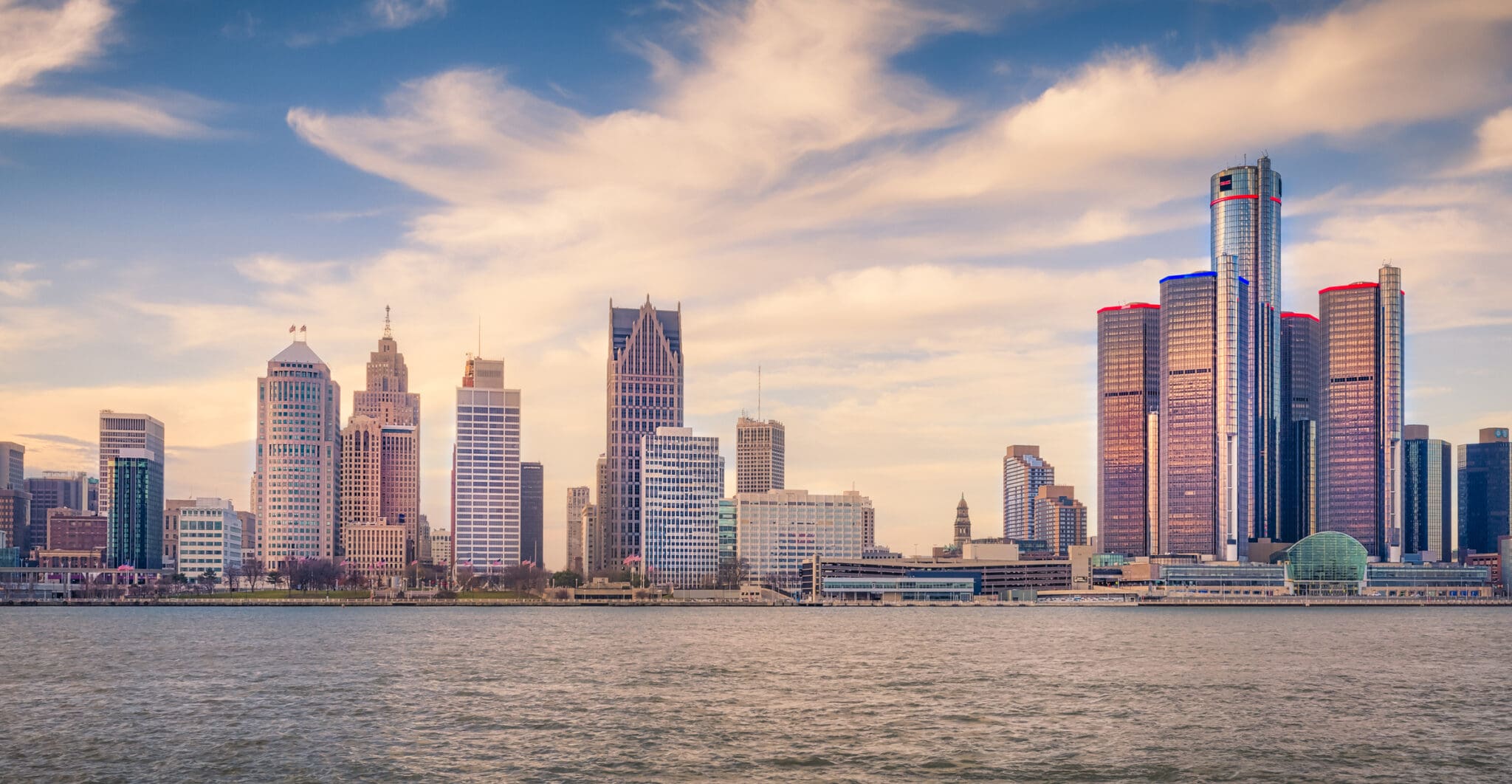
Detroit Skyline, Detroit, Michigan
Nice. How did you get into the FBI and active shooting, mass shooting?
The FBI is just a job like every other job. I was a Special Agent with the FBI, and agents do what they're assigned to do. Although I had been working national security matters—it’s counterterrorism, cyber crimes, and espionage and things like that—when the Sandy Hook massacre happened in December of 2012, I was volun-told, “Hey, hi. We need you to do this now. Stand up a program. Go join then-Vice President Biden's White House team. And you need to work with the other components in the federal government—the Department of Health and Human Services, the Homeland Security, the Department of Education, FEMA. Go work with the other departments and the White House team on Mr. Biden's team, come up with solutions, and see what you can come up with.”
We did that. We were assigned, “OK, you guys are going to work every day. Figure it out.” Because we're going to, oh, we're going to work every day and figure it out. It was very intense. We were very focused on what is the problem? What’s going on?
The product of that was a lot of best practices. I spent a tremendous amount of time with parents whose kids had been killed and schools that had been shot up, principals and things like that. I learned a tremendous amount. Out of that, came things like run, hide, fight, for example, which I think a lot of people are familiar with now.
Let's take a step back, and let's define what is a mass shooting, because I think different reports will call it something different. Just for the purpose of our discussion, let's use specific terminology.
Yeah, I think that's good. I love that you start there, because that is the essence of the challenge with the numbers. There is no federal definition for mass shootings. That is the first answer. Because there is no federal definition, the definitions are created by researchers. Some researchers say, “We want to look at all shootings where three people have been killed, or we want to look at all shootings where four people have been killed.”
The FBI research doesn't look at any number of kills, but the FBI's research is about where does the incident occur? Does it happen in public? Is there a shooter out there trying to kill a bunch of people in a public place? The FBI counts those. They don't call them mass shootings, they call them active shooters.
The FBI counts active shooters, but a lot of researchers through the years have gathered numbers based on how many people have been killed at the scene. There's no real definition for it. In general, the Department of Justice in all of our meetings, we'd like to see as a definition that doesn't have a number. And that's what the Department of Justice says.
It does say where a lot of people are killed intentionally by an individual who is intending to commit violence, even if they don't actually kill a bunch of people. You could have a mass shooting where somebody is running through the mall firing an AR-15-style weapon, and maybe they injure 25 people, but they don't kill any. In some research, that wouldn't count. We want to capture those, so that's why the FBI calls those active shooter situations.
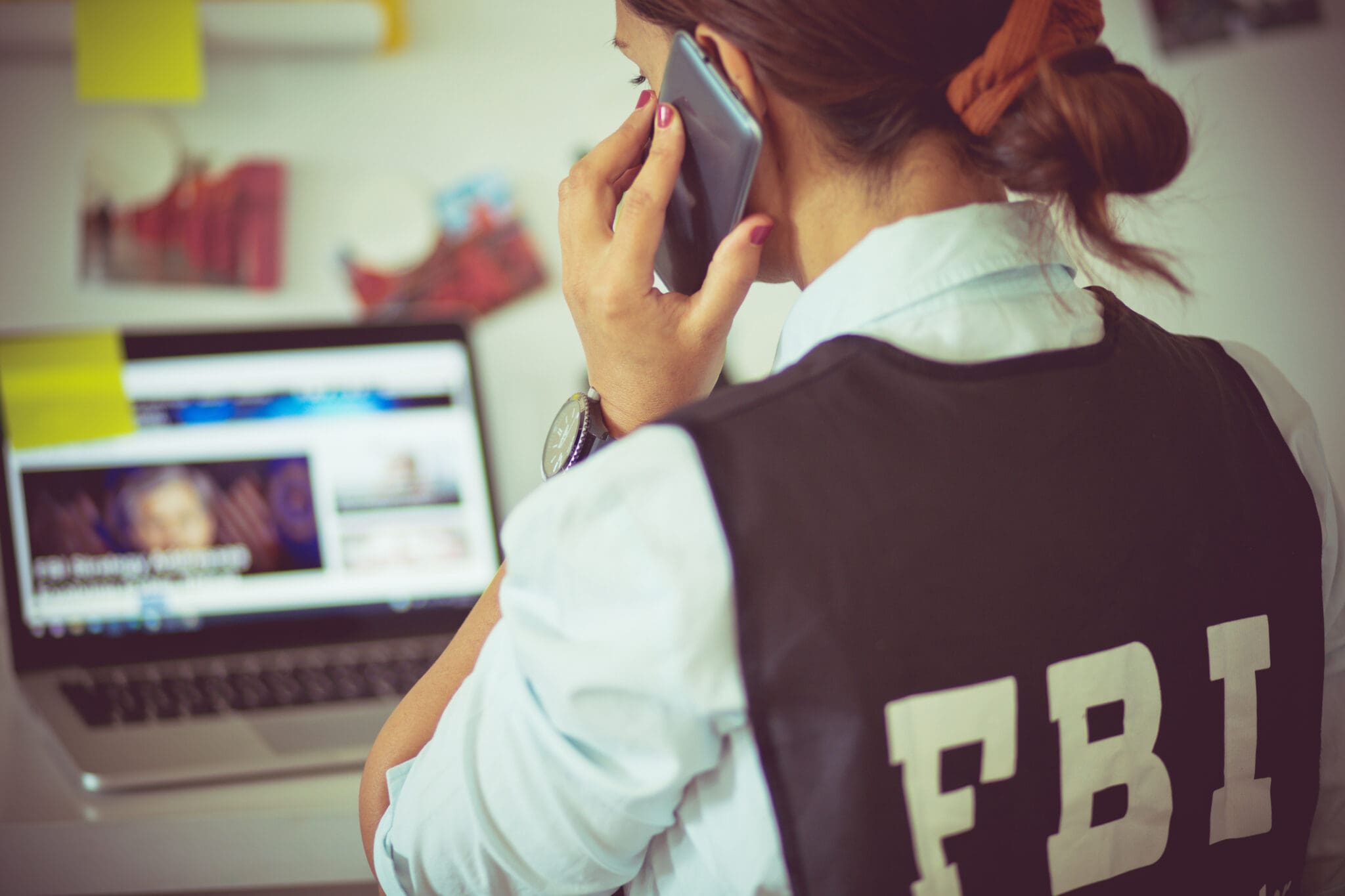
Got you. I think it's important, because you hear different talking heads say, “Oh, there's this many mass shootings.” No, no, that number is inflated, that's really only 10% of that number.
You know what, let me add one thing. Here's one of the things, you're right. When you hear something on the news or on social media, the numbers they're using are just based on how a particular research team is telling them. But one of the things that probably most Americans don't understand and appreciate is at most mass killings in any version of them, three or four people killed, most mass killings occur in the home and in the neighborhoods.
For example, the FBI wouldn't count those necessarily if they were in a home murder, suicide, a domestic situation, which is maybe as many as half mass shootings or domestic situations. If a gentleman kills his wife and three children, and maybe I shouldn't say gentleman, but if a man kills his wife three children, or a woman kills her four children, those are all mass killings. Or it involves a weapon, they're mass shootings, but they're not going to come into a lot of other databases because they occur in the home.
Got you. FBI is looking for stuff that's more public, where other researchers are potentially looking at all shootings whether they're public, domestic?
Exactly, and it all depends on the criteria they're using. I would say, if you hear a common number, look at the bottom of the screen and see where they get their information. Is it from The Washington Post? Is it from USA Today, which is a great resource.
USA Today has a great counting system. Is it gun violence archives? You know, there's a lot of errors at the FBI, there's a lot of different people counting a lot of different numbers, and none of the numbers are wrong. They're just based on different criteria.
Is it the things that the numbers are used to support the political view of those who are speaking?
A lot of times. The numbers are not gathered for political views, but I think different media outlets, different social media personalities, choose to use particular numbers based on their particular position that they're pushing, I think. It's more common.
Bottom line, the numbers are true, you just have to know what they actually are counting. For instance, in the United States, gun violence itself, more than half of the people who died from gun violence die from suicide. People don't think of that, but if we were looking at what is the biggest problem that we have in gun violence, then we should put every dime we have into suicide prevention. We don't do that. There is a little bit of politics on it.
Is it that that's just not as newsworthy, as dramatic, that gets people—I don't want to say excited.
Suicide is not a new story. I was a journalist, and I know that the journalists are giving the public what they want, and the public wants new stories. They want new stories. They want to know what's the latest trend. That's what the public wants, and that's what social media, traditional media tries to give them.
Suicide is not a new story. It's a tough nut to crack, and we need to continue to go after it. I believe we're in the middle of suicide prevention month right now while we're doing this recording, but it's not a new story.
Yeah. To me, that's a challenging thing. These conversations so often devolve into some really little sliver of what's happening that we lose the bigger picture of what is going on broader in society.
Yeah, that's true. I will say that I've had media producers, news producers, who have called me just in the last few months to say, “Is there another way we can tell the story about these shootings? Is there another way that we can tell these mass shootings stories so that it is more effective? We don't want to just run out and cover a story because people get shot.” I admire them for saying that they want to do that, and they want to look for a better way to tell the public and to look for better solutions. I like that.
Have you found a better way to talk about it?
I don't know. I think I have. I think that it's all about the conversation. You have to keep having the conversation. Actually, not to pitch a book, but I'm pitching a book. That's why I wrote the second book I just released called How to Talk About Guns with Anyone, because nobody wants to talk about it fruitfully.
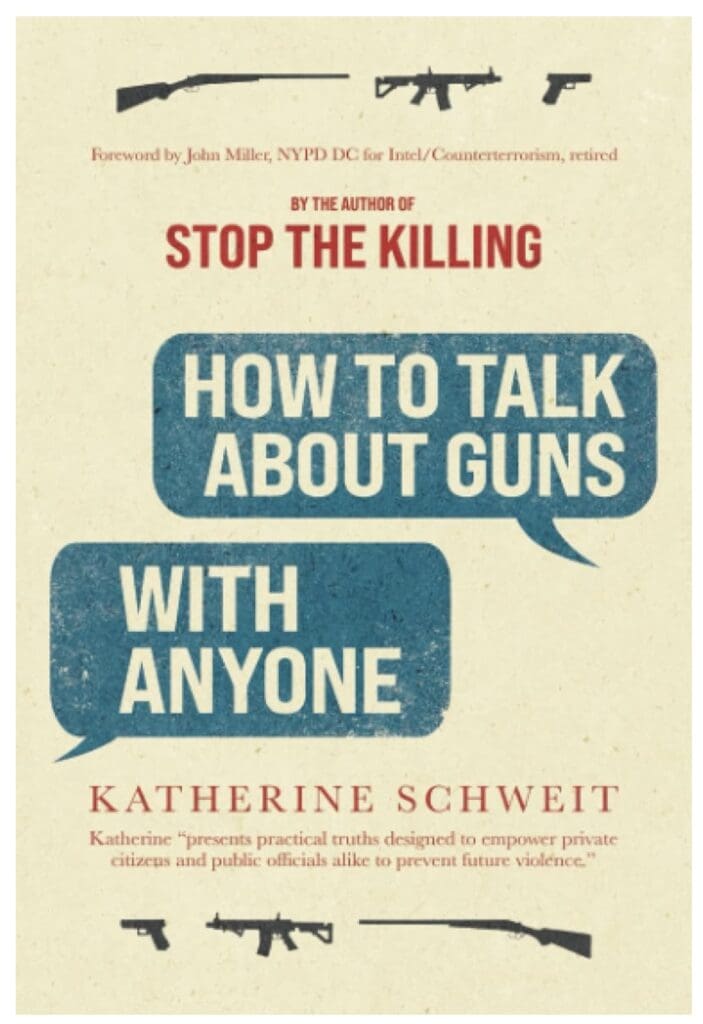
We talk about, “Are you for guns or against guns?” People ask me that all the time. I think it's like, “What do you mean am I for or against? I was an FBI agent for 20 years.”
I'm all about guns in their own way. The solutions, if that's the word, there are a lot of different things that we can do that we're trying. I think we just have to keep talking about it. We have to keep trying these different things. Some people support, because I know you're going to say what, like what. You were going to say it.
Yeah, I was giving you a few minutes.
Some people say that you have to secure all guns, or you shouldn't allow concealed carry, or we should get rid of all semi-assault weapons, rifles, and handguns. There are all these different solutions. Really, what we lack is a lot of research on the effectiveness of a lot of those policies, because those policies, legislative pieces haven't been put into place, so we don't really have the research in a lot of cases to say this is the definitive way to get rid of this or that.
If we don't try some of those things, we're never going to figure it out. If we don't try seatbelts as lap belts, and then try the ones that go across all the way up to our shoulders, we've reduced the death in car accidents, because we first put lap belts on people. And then we realized that if we put a belt that goes all the way up to their shoulder, we could prevent them from going forward, breaking their spine, and things like that.
We’ve got to try it and see. I think that's one of the things we need to do here when it comes to gun violence itself. We need to try some things to see and do some research to see whether they work. I have gone down a rabbit hole, sorry.
No, rabbit holes are good. I like the seatbelt analogy, because I think you could look at professional racecar drivers and the survivability of auto accidents there. You watch these things on TV and you're like, “There's no way this person is going to survive.” They get out and they'll walk away because they've got neck restraints, helmets, they've got five-point harnesses that makes that much more survivable, but there's also a tolerance for the practicality of what you can do in public.
You can't go on a mandate, “OK, well, if you're going to drive a car, you have to wear a neck brace, a helmet, and a five-point harness.” There's a practicality around what the public will accept, at least today.
Yeah, what are the most effective things?
That might be the most effective thing that you could do as a five-point harness, but the practicality of that in public is that it's not going to happen.
I think that is good. Because if it's something that you probably know, maybe your audience doesn't all know, is that in 2020, the CDC keeps track of all kinds of things. The Center for Disease Control and Prevention keeps track of all kinds of things. In 2020, they determined that gun deaths for those youth, 19 and younger, exceeded the deaths by traffic accidents for the same age group. Car accidents have always been higher. And now, 19-and-under gun violence is the highest incidence of death for those 19 and under, and auto deaths continue to go down.
And now, 19-and-under gun violence is the highest incidence of death for those 19 and under, and auto deaths continue to go down. -Katherine Schweit Share on XGun violence continues to go up for that age group; auto deaths go down. How did it go down? There are more cars on the road, we're driving faster, there are more people driving. But we found ways to make the adjustments to bring down those auto industry accidents just because of what you said: we balanced it out. We put in seatbelts, but we also lowered speeding rates in some areas. We regulated, legislated how and when kids could get driver's licenses. We don't let a 16-year-old with a new license drive with other people in their cars, because we know 16-year-olds are stupid, no offense to the 16-year-olds listening.
We've made all these little tooling adjustments state by state and at the federal level. I think we need to do that in the firearms industry, not because firearms themselves are dangerous, but cars themselves are dangerous, because people with cars or people with firearms can be dangerous.
Yeah. We'll pivot back to that, but let's talk a little bit about how law enforcement response to shootings changed. And then we'll talk about what the public can do about shootings when they're happening.
Sure. Thank you for asking, because I think the more that we talk about it, the more we can help educate people, the safer we're all going to be. I would say in the beginning, at the FBI, we focused on these public mass shootings, because I think, although incredibly rare, they're the things that we fear the most. There are so many things that you fear, but the reality is that you don't have to worry about it.
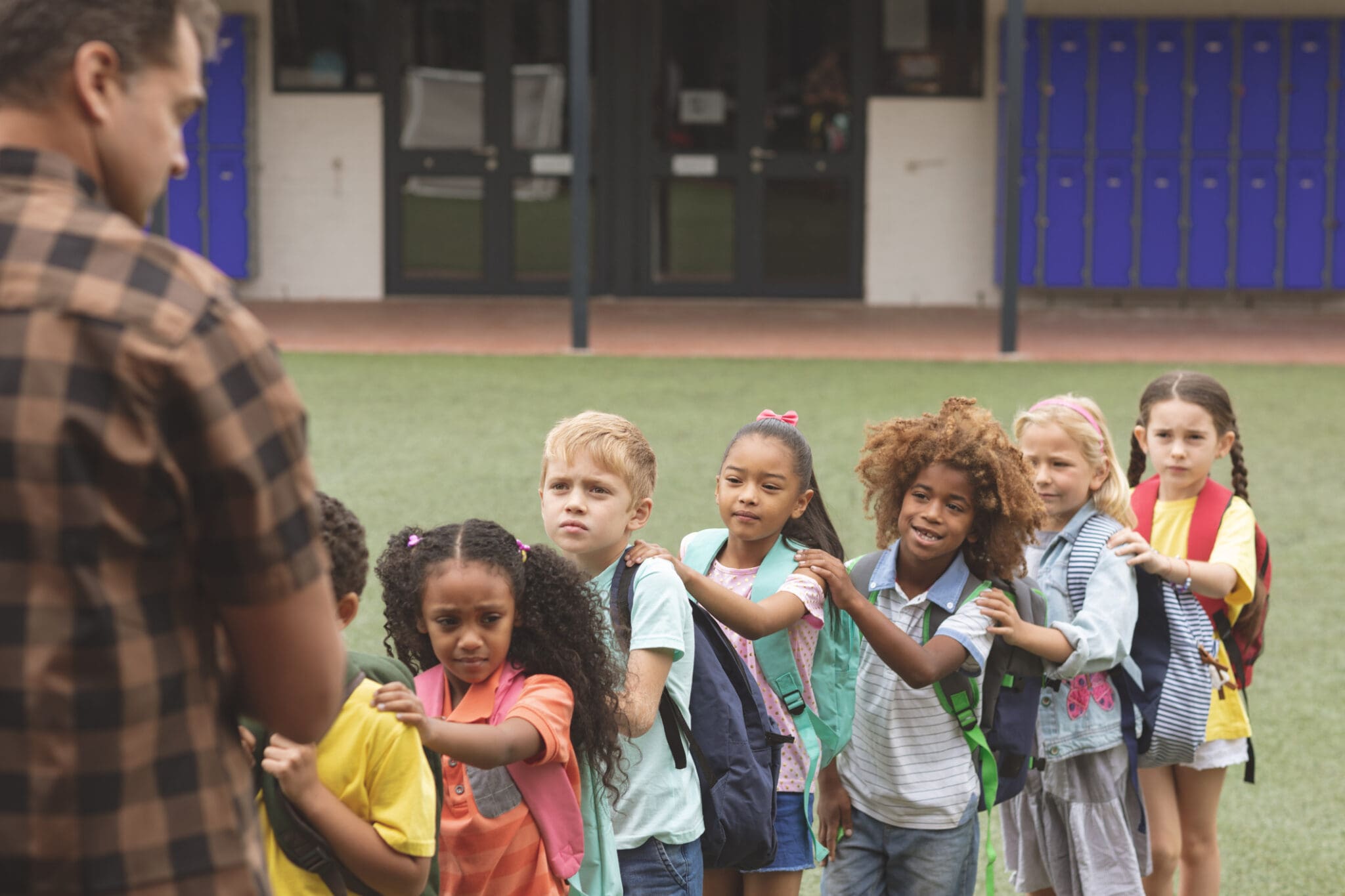
We do fire drills in schools all over the United States. Fifty-million kids run their fire drills two or three times a year, but we haven't lost a child to a fire in a school since the 1950s. We still run in Chicago, but we still run the drills. Why do we do it? We do it so that everybody's ready just in case.
Safety isn't about when it happens. Safety is about if it happens. It may never happen. That's why you put your seatbelt on in an airplane, and you go through the safety drills every time in the airplane, because you just want to be sure that you know what to do if for a chance something happens.
Safety isn't about when it happens. Safety is about if it happens. It may never happen. -Katherine Schweit Share on XIn the United States, we never really dealt with, in any great amount, school shootings. We never feared school shootings, and then Columbine happened. But there had been shootings before that in the 60s, 70s, 80s, Texas, California. A lot of other places, there had been shootings out in public. We had tried to overcome those one at a time, one at a time. But when the Columbine High School shooting happened, that really changed the public's view, and it changed the personality of how law enforcement felt they needed to respond.
Before, law enforcement was trained to contain and wait, meaning that the first officers who showed up created a perimeter, and then made sure that nobody stepped in the perimeter, and nobody got out of the perimeter if they were a bad guy. Then we waited for our special weapons and tactics, teams, our SWAT teams to arrive. And the SWAT teams arrived.
The SWAT teams had, in fact, been created after some of these earlier shootings, where we said, “Hey, we need to have really specialized people who know what to do, instead of a law enforcement officer who might have a shotgun in his car and maybe a handgun on his hip. We need to train a special team that can come. When there's a real bad problem, that special team, that SWAT team can come and handle this assault.”
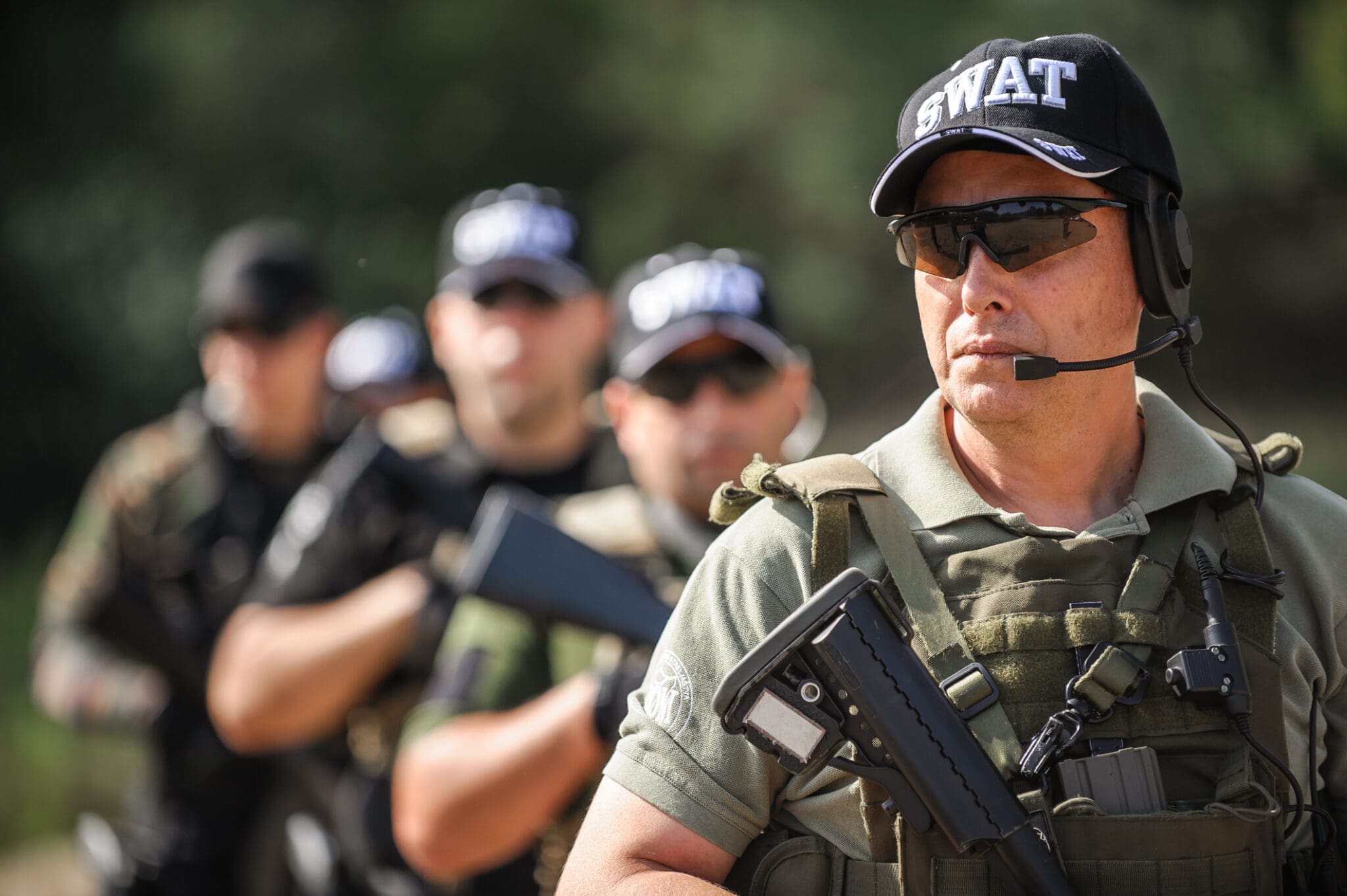
We created a situation thinking it was best practice to have officers who arrive at the scene contain and wait until SWAT arrives. But at Columbine, we waited, and SWAT arrived, and then SWAT worked out a lot of things. But SWAT didn't go right into the building right away. However, that impacted the deaths inside the building. It was perceived as a challenge and a failure of communications and entry. After that, we began to teach law enforcement after Columbine that they must find a way to get inside the building quickly and swiftly, and that their primary job was to get to the shooter.
If you fast forward from 1999 when that happened to 2012 when Sandy Hook happened, when I got assigned to run the FBI's program, we looked at, “OK, what is law enforcement doing now?” One of the things that we found is that, virtually, law enforcement had essentially access to some SWAT teams, few law enforcement had the training to safely and successfully go to neutralize the shooter. And that's really what we changed.
We invested millions of your tax dollars and your listeners’ tax dollars in training law enforcement across the country to respond the same way so that we could be sure that if I arrive as a law enforcement officer, if I arrive at a scene, the other law enforcement officers who arrive at the scene are going to do the same thing that I do. We're going to have the same training to know for sure, just like your dentist knows how to take the cavity.
When you go to the scene, we want everybody to respond the same way. We changed that buildup and created a situation where we anticipate and we expect now for all law enforcement. Their first job is to neutralize the shooter, whether by shooting them, arresting them, or whatever the situation is. Neutralize the shooter, then turn immediately to life safety to recover and save lives.
Have the studies been done to find out, is that more effective or believed to be more effective?
Yeah, I think it is. We're still piecing together the studies the more time you have. Fortunately, even though it seems like these are occurring every day, these types of shootings are not as frequent as the news might make you think of these public mass shootings, so you have a smaller number to look to to look for your statistical significance.
One of the things that we found in the FBI's research of 25 years of these shootings, is that half of them occur in places of business, only about 20% in schools. That helps us to understand where the threats really are and who might be the perpetrators. Of course, in places of business, you have people who are employed and working there or are recently fired. That skews the age up, for instance, for a shooter.
One of the things that we have found is that, through the years, this 25 years, we saw the number of incidents increase. That is not a fallacy. We've seen the number of incidents increase, but we haven't seen the number of casualties increase. That tells me that the law enforcement response and civilian response has been much more effective, where we've seen a lot less, percentage-wise, increase in casualties.
Got you. We know there was the Uvalde.
Uvalde, Texas, the elementary school.
Yeah, where it looks the perception as I don't know the facts. I wasn't there, so I want to be careful about it. Perception was that law enforcement did not act in a consistent manner with what they were taught. There's still a bit of if the first people on the scene aren't following the teachings and the practices that everybody else is showing up, it goes into almost like, “I'm just following orders now that someone else is in charge.”
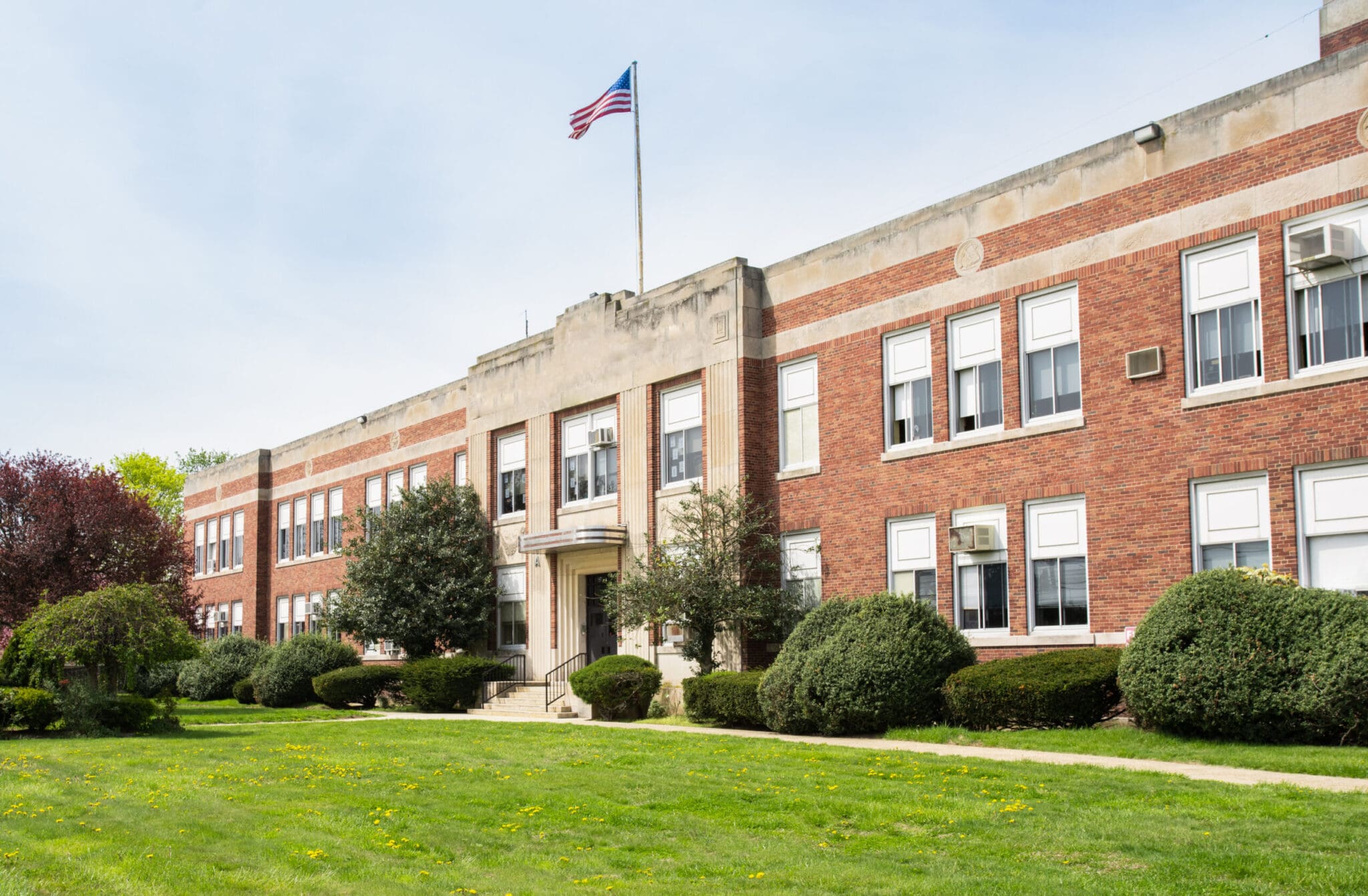
Yeah. The Department of Justice, actually, I think hasn't released this Uvalde report yet. My understanding is that, just absolutely to what you mentioned, Uvalde Elementary School, two adults, 19 children killed if I have my numbers right. I apologize if I don't. The circumstances we absolutely saw were that initial responders came right into the building, but then they didn't follow and pursue the shooter into the classroom where he was.
After that, it became a communications breakdown. The subsequent time that went by didn't get any better. I think we'll see a very detailed report from the Department of Justice about the details of it. But in essence, you're right. I agree with you that the police response was not the protocol that we train them in.
In fact, they had that training. But then once you don't execute those first few steps, a lot of confusion on the ground can make it really challenging. I know there were radio communications that talked about barricaded subjects, and that's a whole different protocol.
Yeah. That's the challenge of, when I say us, it's the people that are not in law enforcement looking at it. We're like, “Oh, what's wrong with them? Why didn't they do X, Y, or Z?” It's a complicated situation with complicated responses, depending on what the situation on the ground is.
Yeah. I think it's hard for any civilian or any person who hasn't been in that environment to truly appreciate how chaotic those kinds of scenes are. It's easy afterwards. It's not easy, of course, but it's more understandable afterwards to see the communications and see where people moved and say, “Oh, I see the whole picture, and this is what should happen.” But that's not really what happens on the ground.
If you're a law enforcement officer, and you're on a perimeter at the corner of 12th and Maine, and something is going on in a building over there, you don't even have radio communication with what's going on in that building, so you don't even know. There isn't this whole full blanket of everybody having all the communications going on everywhere, and everybody knows what everybody else is doing. It just isn't that way at the scenes. It's very chaotic.
I think some of the fault of that is television shows that play these things out.
It's an expectation.
Yeah, it's the CSI effect on their behaviors. In the TV shows, they have access to all the cameras instantly, remotely.
Yes, which we never do. I could tell you the nightmare stories, hour-and-a-half looking for somebody in the navy or a building in downtown Washington, DC, cameras all over the building and no access to the cameras, and in fact, didn't even know the cameras existed because the guy who ran the camera systems, when the fire alarm was pulled, locked the room and left the building.
Which was probably the protocol that he was given.
He was just following this protocol for a fire drill, right? Nothing wrong with what he did. He was doing exactly what he was told. You're right. I think our expectation is that social media, everything is instant, Instagram, everything is very instant. We watch television shows where everything gets resolved in 15 minutes, and then people are standing in the bar having a beer. That's not the reality of really what happens. It's very chaotic.
It isn't until long afterwards, that's why we do after-action reports. It isn't until long afterwards when we are able to interview everybody, check the transcripts of communications, check phone lines, voicemail messages, text messages, and then we put it all together, and then it all seems really simple, but it's not simple at the time.
No. Let's talk about it from the public's point of view. What should the public be doing when they think there is a mass shooting event in progress?
I liked that you asked me that, because that forgoes that question about, what did they do before? And I think there are things I need to do before. There are three things I think they need to do before. Then if they have done those things, then they'll know what to do when something happens.
If you would have obliged me and let me just back up a little bit, the first thing is the classic see something, say something. I think we're familiar with that because we did a great job of marketing after 9/11 to say if you see something, you should say something. Certainly, we don't have time today to go through the details of this. But if you want to know what to see and who to say it to, I'd say listen to my podcast.
My co-podcaster Sarah Ferris, our podcast is Stop the Killing. And every week, we talk about signs to look for, how to report them, the nuances of who to report them to, when to report them, and the struggle and the challenge with reporting it, because nobody wants to say their kid is bad.
The essence of the first thing is see something, say something, is an essential part because we can prevent these, but we can only do it if the people who are around the shooters, FBI research shows, law enforcement is 25% likely to get—this is a bastardization of the FBI data, but 25% of the time, law enforcement had information about shooters in our initial research, 75% or more, family, friends, classmates, 92%. Spouses, personal relationships, 80-something percent.
Seventy-five percent more friends, family, spouses, classmates, teachers, had information that was definable, written, articulable information and did not share it. And sharing it might have prevented a shooting that actually occurred. Law enforcement is not the one to get it. That's the see something, say something part.
The second part is something that maybe not a lot of people know about. If I asked you if you'd had a First Aid class if you went through Scouts, or if you were a lifeguard, you would say, “Oh, yeah. I had First Aid.” But what we never had when I was growing up is we never had any training in how to apply a tourniquet or how to stop when a bleed is occurring. If you go to stopthebleed.org, you will see a companion effort.
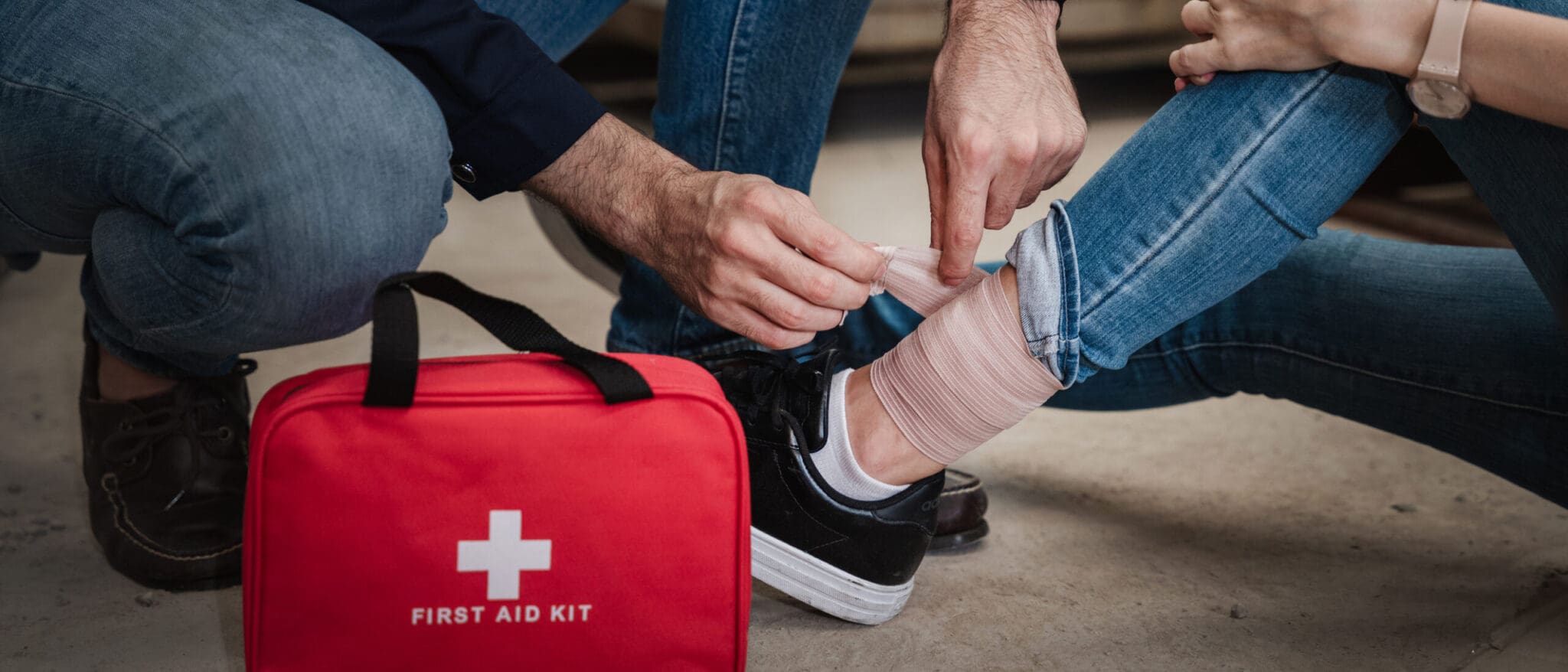
When I was working on our White House team, there was another team working that created stopthebleed.org, which is a way to properly put on a tourniquet, but also properly stop excessive bleeding that saves lives. It takes just a few minutes for somebody to bleed enough that we cannot bring them back.
If it takes the ambulance 15 minutes to get to your location, and it takes 30 minutes to transport a person to the hospital, if an ambulance and a medical personnel don't get there for 15 minutes, if the law enforcement on the scene, or the civilians on the scene don't know how to stop the bleed when a bone is broken when somebody's in a car accident, that person will bleed out. You can look at stopthebleed.org, get some training, and understand the value in you just stopping the bleeding on a bleeding wound. You can save a life, and we know hundreds and hundreds of people have done it, thousands of people have done it.
If you know how to stop the bleeding, and you see something and say something when you can, then what that leaves us with is this massive comment about run, hide, fight, which is the third thing. What do you do when something happens? You should have run, hide, fight training ahead of time. You should read a little bit about it, because you should know that you're capable of doing all those things.
We're all flight-or-fight individuals; that's our human nature. Our first natural reaction is to run. That's why the FBI and the federal government adopted run, hide, fight. DHS supports run, hide, fight, not because these are three magic words, but because these are the three actions that people do.
We're all flight-or-fight individuals; that's our human nature. Our first natural reaction is to run. That's why the FBI and the federal government adopted run, hide, fight. -Katherine Schweit Share on XRun, hide, fight was developed by the city of Houston Mayor's office and released in July of 2012. It's available in multiple languages. There are huge training programs with it in addition to just a little six-minute video. The video itself doesn't have any blood. There's only a couple of gunshot rounds discharged at the very first few seconds, so it's relatively low when it comes to trauma. That's why we relied on that training.
I've done hundreds and hundreds of interviews and been at locations where shootings occurred. I've read so many after actions, and everybody at the scene runs, hides, fights, or does some combination of those. That's what you need to be prepared to do.
If there's no danger in front of you, then that's where the middle part gets in—hide—where the schools teach about lockdown. We want to maintain your location, if you can, if you're not in danger. But if you're in immediate danger, your safest bet is to run. I can tell you, there are children today who ran from the classrooms at Sandy Hook Elementary School who are now adults, and they're alive.
There are students from Virginia Tech University, who jumped out the second floor window at Norris Hall. They're alive today because they had the competence to do that, because their instructor who died holding the door closed, Professor Librescu, told them to jump out the windows. They all jumped out the windows. There were a couple of broken ankles, scrapes, and things. But all those kids survived because they made the decision to run.
You cannot be killed if you're not there, so run if you can, hide if you must, and absolutely, you should always fight. You can fight. Even though you might not think you can, you can fight with your fists, you can fight with a group of people, you can fight by pushing, you can fight by holding the door closed, you can fight in a lot of ways.
You cannot be killed if you're not there, so run if you can, hide if you must, and absolutely, you should always fight. -Katherine Schweit Share on XI'll tell you one statistic. When I started to do the research on this with my team at the FBI, probably the most astonishing piece of data that came out of the initial research that I wrote for the FBI was that my team worked on is that in 21 of 160 instances, so 13% of the instances, an unarmed civilian safely and successfully stopped the shooting. An unarmed civilian, 13% of the time.
And that's not 13% of the times that they tried, but 13% of the overall incidents.
Those were successful, right. Thirteen percent were successful in the overall incidents. Yeah.
I'm just trying to clarify the statistics. It's not that 100% of those cases, someone tried to fight and 25% of the times, someone tried to fight. That 13% really means it was 50%—I'm exaggerating numbers—50% successful when someone tried to fight.
Yeah, exactly. If I can re-articulate it, what you're saying is, and I agree with you, we had 160 incidents of active shooter situations, 160 actual public shootings, where an individual was actively engaged in killing or attempted to kill people in a crowded area. In those 160 incidents, there were certainly people who tried to go after an attacker, or there were instances where the shooter killed some people, left the building, committed suicide, and things like that.
In some instances, law enforcement came and engaged the shooter, but less of those than so many other things. But where the shooting was stopped at the scene, successfully, 13% of the time, 21 instances, where individuals who were facing somebody with a weapon were able to stop the shooting. In some instances, like I mentioned, Professor Librescu at Virginia Tech, he obviously tried to stop the shooter. He was unable to stop the shooter, but he was able to delay him.
There's a Sandy Hook teacher, the same thing. They were able to delay the shooter by getting in their way and taking the bullets, and that allowed other people to survive. Of the 160 incidents we studied, 13% of them were successfully stopped. There were other percentages that were stopped, half of them were for this reason, or 20% were for that reason. Thirteen percent of the shootings were stopped by unarmed civilians, so it's pretty cool.
It's pretty amazing.
Yeah. It was the most shocking piece of information that came out of that. There was one other shocking detail of the shootings where law enforcement had to engage. This is when we decided how important that training was for law enforcement. When law enforcement had to engage the shooter to stop the fighting, to stop the shooting, 47% of the time, a law enforcement officer was killed, injured, or both. Half of the time, when law enforcement had to engage, we were like, “Oh, a dead cop is a no-good cop. We need to do a better job of getting those law enforcement officers trained so that they can stay alive to save the civilians.
It seems to me that each of the run, hide, and fight also have a before element in a sense, that if you don't know where to run, you don't know where to hide, you haven't thought about how you would fight. There's a diminished utility to those things.
Yeah. I think that's great that you bring that up too, Chris, because that is the value of thinking about it ahead of time, and thinking about it and doing some training in it. It isn't about running. Some places use avoid, defend, deny. In England, it's run, hide, tell.
In other places, they'll say, “Hey, we want to make sure that we use”—I don't know, there's a lot of versions. Some people are trained in ALICE, which is a corporation. That's their branding, ALICE. All the branding means all the same thing. No matter what words you use, it's the idea that you need to think that you might have to run. If you did run, where could you run?
I'll tell you that most people enter and exit buildings and parking lots in exactly the same way every time. Sometimes people, when they go to flee a building when there's a fire, or when they go to flee a building because there's a shooting or anything, or a storm, they go to the same place they came in, even though there's a much safer exit in another location. The simple thing you can do is look for the exits.
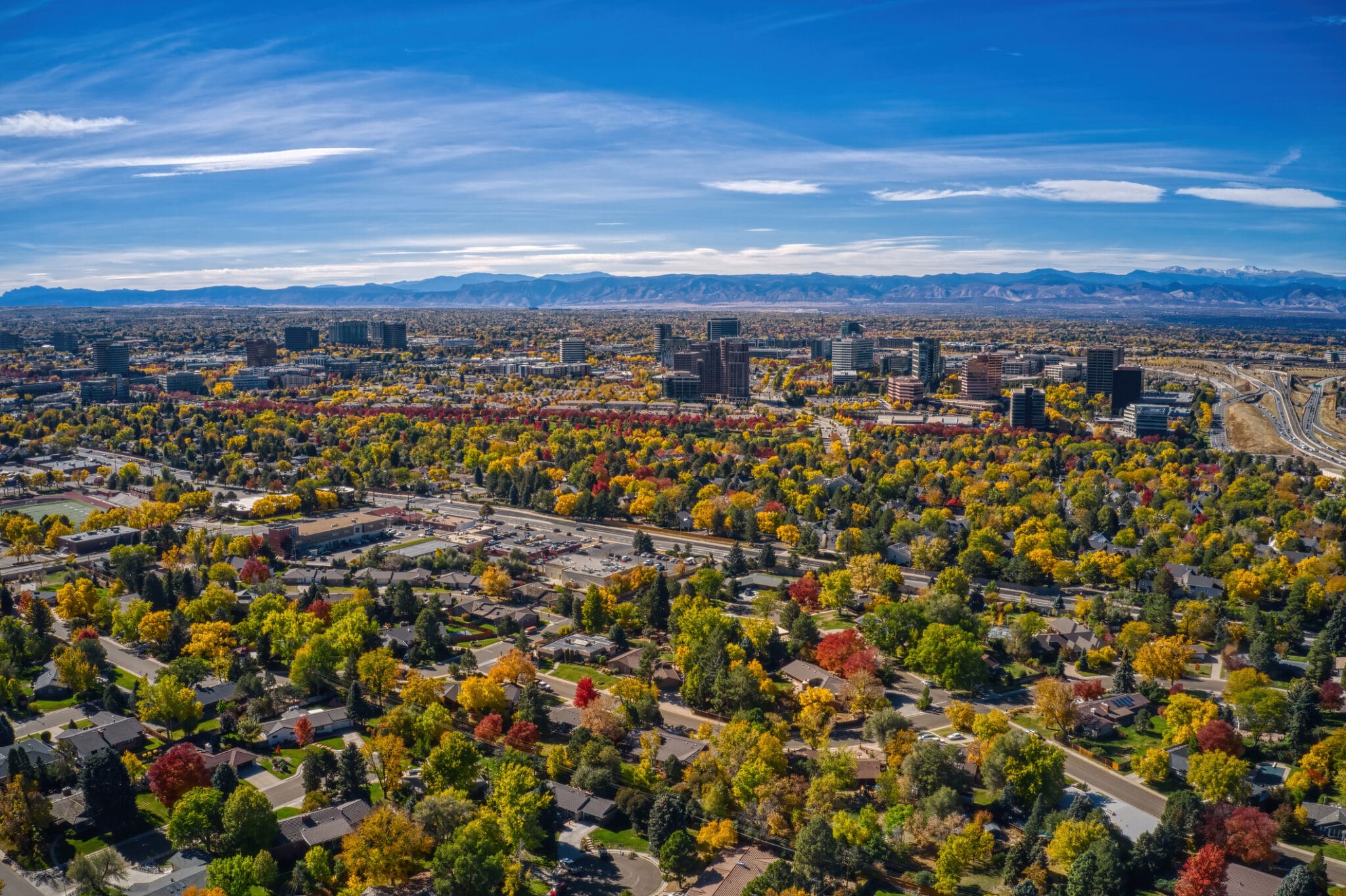
Aerial View of Aurora, Colorado
The shooting in Aurora, Colorado, at the theater, their shooter came from the bottom of the theater that was just the amphitheater, where the seats go up really high. There were exit doors in the back, and nobody thought to run up and go out the exit doors that are essentially almost in the second level. They were there, but people were trying to rush out of the doors that they came in, which really put them closer to the line of fire, because they had to come down and towards the shooter in order to get out.
It's not the fault of those people by any means, it's the shooter’s fault that people got injured or killed. But we can do such a better job of just looking where the exits are when we come into someplace, or not using the exact same doorway every time so that we know what might be on the other side of that door. It's an observational thing. Be prepared for a potential run for any reason, even if it's a fire or a tornado.
But we can do such a better job of just looking where the exits are when we come into someplace, or not using the exact same doorway every time so that we know what might be on the other side of that door. -Katherine Schweit Share on XBe prepared if you have to hide, because you want to hide someplace not just on the other side of a piece of wallboard or a soft pod in your office building. You want to hide inside of a stone bathroom if you can. If there's no place to hide, ducking under a plastic desk with metal legs is not hiding.
That's what happened in Virginia Tech. Everybody bent down to the floor and then stayed there. That's what happened in the San Ysidro McDonald's in the 70s. Everybody ducked underneath the plastic desks in the McDonald's. That's not hiding.
Was that a byproduct you think of duck-and-cover of earthquake training that that was the only thing they could do?
I think that we think about going down, and everybody's going to go down. Everybody's going to flinch. I think what run, hide, fight training gives you, gives everybody, is you're welcome to duck down. You're welcome to be shocked. I don't really think this is reflective of earthquake training as much as it is—because I'm from the Midwest, where we don't have as many earthquakes in the upper Midwest. It's more a function of freezing. You freeze, you duck down, and everybody does that.
We see that happen all the time. That's great. But if you're trained, and you're going to think about survival. You should freeze, duck down, and then get up and run. That's what you need to do. That's the practice of knowing ahead of time. “I'm not going to stay here.” Don't stay someplace where you have no protection.
If you have no cover, there's no way to protect you in the spot that you're in, and you're just sitting down on the floor. I've talked to victims who survived who said, “I turned my face away.” That's very common. It's very, very common that a victim who survived will say to us afterwards, “Well, I got down on the floor, and then I turned my face away so he wouldn't see me,” which of course, is nonsensical, but it is the way that as humans, we think.
I've heard so many people I've interviewed who have said things like that. What we want to empower people to say is, “Go. You know what? Go. Even if you go past and at him.” I know people who have run from shooters down hallways. People say, “Oh, should I zigzag in the lawn as I run away?” No, just go. Just go as fast as you can.
Active Shooter Preparedness with Katherine Schweit Share on XThe bullets go down. When they come out of the barrel, they go down. They go down, and down, and down. The further away you are, the better chance you have of not getting hit. A bullet that hits the ground will skid until it finds its target.
I know somebody who got hit in the foot, because the bullet hit the ground and then skidded into her. I know somebody who took a bullet in the shin that way it reflected off of. You don't think of the bullets being there. But if you lay down on the ground and think you're safer, all you're doing is creating a bigger target.
And more vital organs.
More vital organs, right. That's the run and the hide. How often do we have to fight? Very, very rarely. But if you think about fighting to save your life or the life of your child, every person who you interview in your lifetime, if you said to them, “Would you do anything to save the life of your child? Would you do anything to save the life of your mother?” They would say, “I would do anything to do that.” That's the determination that you need to have on that rare, rare, rare occasion, where you will not give up, and you're going to fight.
You'd be amazed at how many people have done that in ways that they've done it. I mean words. You can fight with your words if you need to. Although if somebody's already shot people, they're going to shoot other people.
I'll leave you with this one thought. Shooters come in with an intent. They have a focus. They have a plan. They develop this plan, and they plan for it. None of this is snapping. This is all a planned, targeted violence. They plan it, they prepare for it, they buy the stuff they want. They get kitted up so that they can pretend to be somebody that they're not really, and they have this plan to do X. They don't have a plan to have anybody intercede.
They're not planning for, “Once I do this, and then that guy is going to come running after me.” I've seen some amazing video footage. I've talked to people who have interceded. The shooters are not expecting anybody to interrupt them.
For instance, up in Wisconsin, there was a shooter who was shooting a facility, a Sikh temple, actually. The law enforcement arrived, and they had their sirens on. That threw the shooter off. The shooter, when he came out of the building, we think he might have been going around to try to go after people who were exiting out of the backdoor. But when he saw law enforcement, that completely changed his plans. He forgot about the people he was trying to kill, and he turned towards law enforcement.
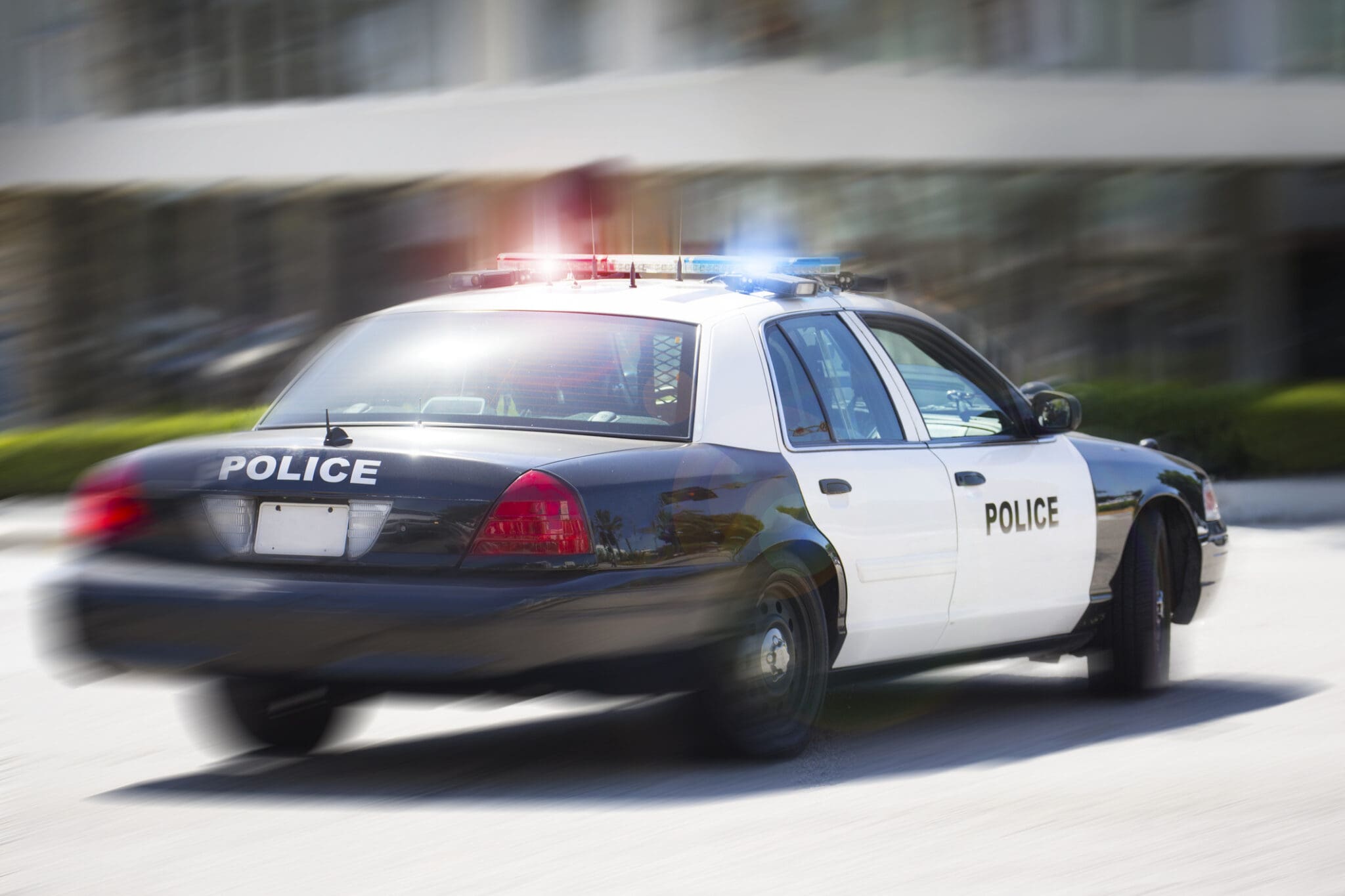
We see that a lot, where there's one distraction. One thing, people fighting back. There's a great video you can pull off YouTube from Seattle Pacific University of a building monitor at the university who was a college kid who saw a shooter come in. The shooter didn't see him, and he walked around beside the shooter and grabbed his shotgun on the side. The kid couldn't shoot and started shaking it, shaking, and shaking it, and knocked the guy down on the ground.
He took the shotgun away. He went and sprayed the guy. The guy pulled a knife out. Very quickly, the whole plan went downhill as far as the shooter, because he didn't expect that somebody else would intercede. You can do that in so many different ways. If your life depends on it, if the life of your family depends on it, if you want your family to see you when you come home, you have nothing to lose and everything to gain.
Are there any particular fighting actions that were more effective than others? I always tell my wife, if anything happens, you play as dirty as you possibly can.
The answer is yes. There are no rules in street fighting. You do whatever you can do, throw anything at them, hit them anywhere, kick them anywhere, gouge their eyes out, whatever you want. Generally, it's a very momentary fight. We're not talking about a situation where you have to fight to the death in a 15-minute brawl on the ground. There are other people around.
It's not The Bourne Identity.
Exactly right. Think about it. These shootings that occur, they occur in public, and the public comes and joins in. They do the pile-on game, which is fantastic. I love it. When you see somebody who does something improper, stupid, and criminal, out in public, and then the public piles on and says, “We're just going to flatten you on the ground until we can get law enforcement here,” you're not alone.
I think that where some people have fought back, that's one of the things that they've seen. For instance, in a school where four or five people have tackled somebody, you act quickly, you do it all together. It's a question of using the resources you have. If you're only one person, you're picking up whatever you can. If you're a bunch of people, you're using a little gang activity on them, and that's good.
It's faster. It's more confident in knowing that you can succeed. I guess the part about the fight is that nobody wants to do that. Nobody wants to fight to stave off a shooter. But if you were being mugged on a platform at the subway, in your school parking lot, or at the mall, and you had an opportunity to fight somebody who was trying to hurt you, you would fight them. It's better that you fight them than to just let them kill you.
There are lots of techniques; all of them work. The bottom line is, as long as you cause a disruption, you're good. Usually, a lot of other civilians are present and can help you. You have to have the knowledge to do, to know. Run, hide, fight are your options. Apply any or all of them, and execute them as long as you need to.
Got you. The reality for parents, I think, on how safe are your kids in school, is our fears worse than the reality?
Way, way, way. Children are much more at risk in their homes for a host of reasons. In 2020, the CDC reported more than 500 unintentional deaths by firearms, and primarily the highest number were kids. Those were primarily kids who found unsecured guns and killed family members or friends.
It's not only just the accidental—a gun that's left out that some child uses—but domestic violence. Kids are much more likely to be injured in a domestic violence situation at their home—murder, suicide situations—that cause a child's death, but also domestic violence causing a child's injury, whether it's by a parent, a step parent, or somebody who a parent is dating, things like that.
Children are way more likely to be injured in their own home by accident, by intentional discharge of a firearm or another weapon, and by domestic abuse, compared to in schools. Schools are way safer for kids. We saw those numbers change, even when the pandemic occurred, and kids were home all the time.
They're at a higher risk at home. Not that homes are dangerous, it's just that there's more activity that the child might be engaged in that might result in their harm, whether it's literally an accident falling off downstairs or something, an accident, an intentional act, such as with a firearm or another weapon, or domestic abuse. But kids are much safer in schools than they are at home.
Got you.
I think we think that because we're not in our charge. We think, “Oh, I don't know what's going to happen to them there.” I think if you turn it around and you say, “How often do these school shootings happen?” Not nearly as often as you think they do. There is a super rare occurrence in our elementary school. When it does, then it's news for a month.
Middle school and high school shootings are generally middle school and high school shooters from that school. The better and stronger your school programs are, the better the schools are able, and the better your parents are in supporting those neighbors are, the stronger your school is in being able to find a potential shooter who is their own student, then the better you're able to find that student before they shoot somebody or before they fire occasionally.
I don't want to disregard the fact that we have people who leave school, kicked out of school, 18, 19, 20, 21. That age group, all primarily males, certainly come back to shoot at schools. And when they do, it's generally their school.
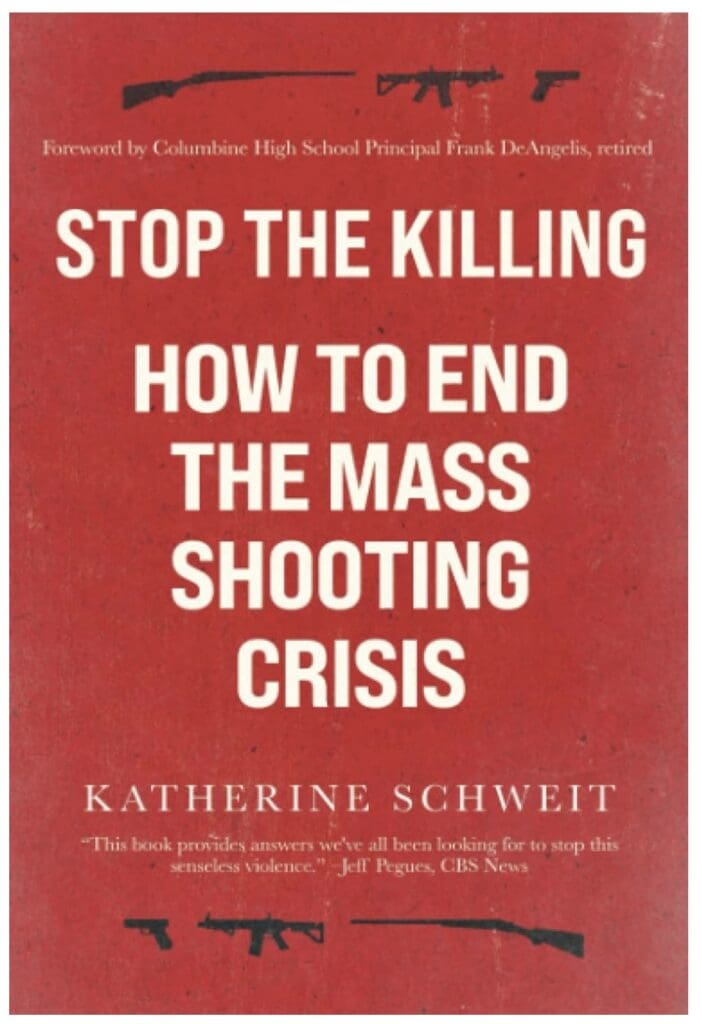
If people want to find out more about what you do, your books, where can they go?
Katherineschweit.com is a great place to start. I have two books out. Coincidentally, I have them here. Stop the Killing: How to End the Mass Shooting Crisis and How to Talk About Guns with Anyone, which I just really wrote the latter one because I want some facts out on the table. When people are talking about firearms and violence, they have better facts.
People always say, “Are you for or against guns?” It's not for or against guns, it's better knowledge about gun laws. It's gun policy, gun culture. What the Supreme Court has said, that's what that little book is about.
I'd be thrilled for anybody to listen for free to the podcast, Stop the Killing, which you can download on Amazon, Apple Podcasts, wherever you find your podcasts, Spotify. That's where I am.
You could find me sitting here in my office, which is a mess right now because I'm recording. I'm recording an audio book. I'm recording this in audio format. My office is covered in moving blankets right now, but I appreciate that you found the time to find me today.
Katherine, thank you so much for coming on the podcast.
It's my pleasure. Thank you very much for sharing this information. I think it's so important. I really appreciate that you spent the time to do this. Thank you.
You're welcome.
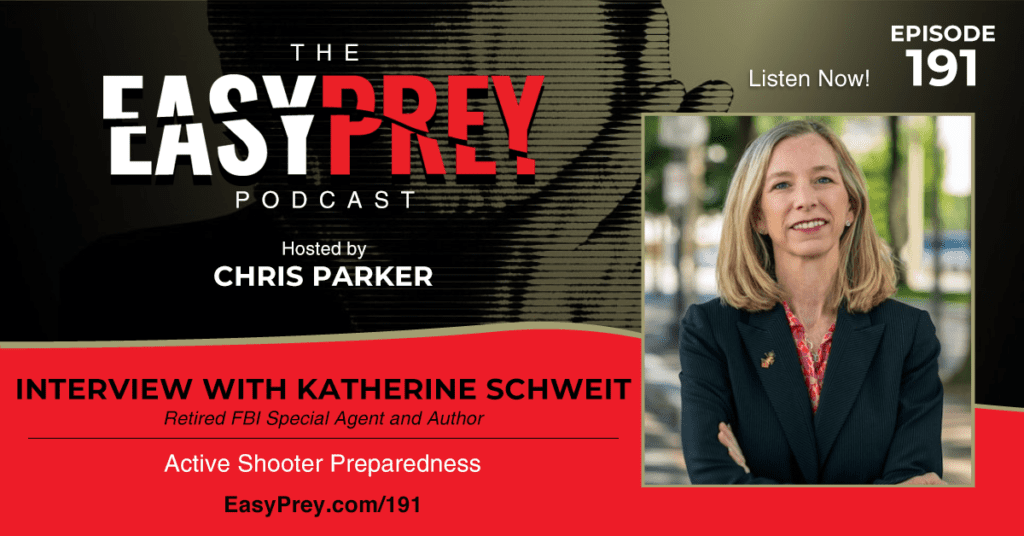
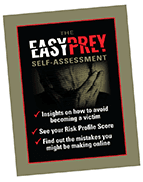
Leave a Reply